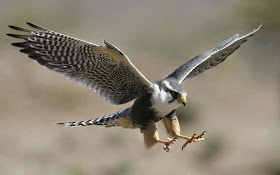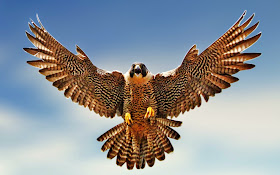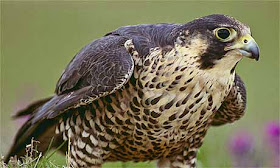Wednesday, December 10, 2014
Falcon
Falcons are medium sized birds of prey found all across the world although falcons tend to prefer the more temperate regions of the Northern Hemisphere. Falcons are best known for their ruthlessness and their incredible flying abilities.
Falcons have tapered wings that allow the falcon to change direction extremely quickly especially when compared to other birds. Falcons have been recorded diving at speeds of up to 200mph, meaning they are the fastest creatures on the planet!
There are more than 40 different species of falcon that can be found all around the world such as the peregrine falcon and the black falcon. Falcons vary in size from 25cm tall to more than 60cm tall, but the height of the falcon depends on the species. The peregrine falcon is the most common bird of prey in the world and is found on every continent besides Antarctica.
Falcons are birds of prey and are therefore known for their incredible hunting skills and being a ruthless, dominant predator within their environment. Falcons hunt their prey from the skies above and swoop down through the air to catch it once they have spotted a meal with their incredible eyesight. Falcons hunt all kinds of small animals like mice, frogs, fish and falcons will even catch small birds in the air.
Due to the large size, speed and alertness of the falcon, the falcon has few natural predators and even fewer that are actually airborne. Humans and wolves tend to be the main predators of the falcon on the ground and eagles and even large owls have been known to hunt the smaller species of falcon (and of course the young and inexperienced falcons) in the air. The eggs and chicks of the falcon are particularly vulnerable to being eaten.
Falcons have adapted in many ways to maximise their chances of survival in the skies. The falcon has tapered wings that allow the falcon to be more agile; incredibly acute eyesight which enables the falcon to spot prey on the ground far below; an aerodynamic body shape means that the falcon glides through the air more easily and a sharp pointed beak helps the falcon to grab and eat it's prey more effectively.
Falcons nest on high ground such as mountains and cliffs and in the tops of tall trees. This means that the vulnerable eggs and chicks of the falcon are in the safest place possible. Falcons start to breed when they are about a year old. Female falcons lay an average of 3 eggs per clutch and look after their chicks until they are big enough and strong enough to fend for themselves.
Falcons are generally solitary birds and only really come together to mate. Although falcons are known to stay in the same place, many species of falcon are migratory birds and have been known to travel more than 15,000 miles per year.





No comments:
Post a Comment